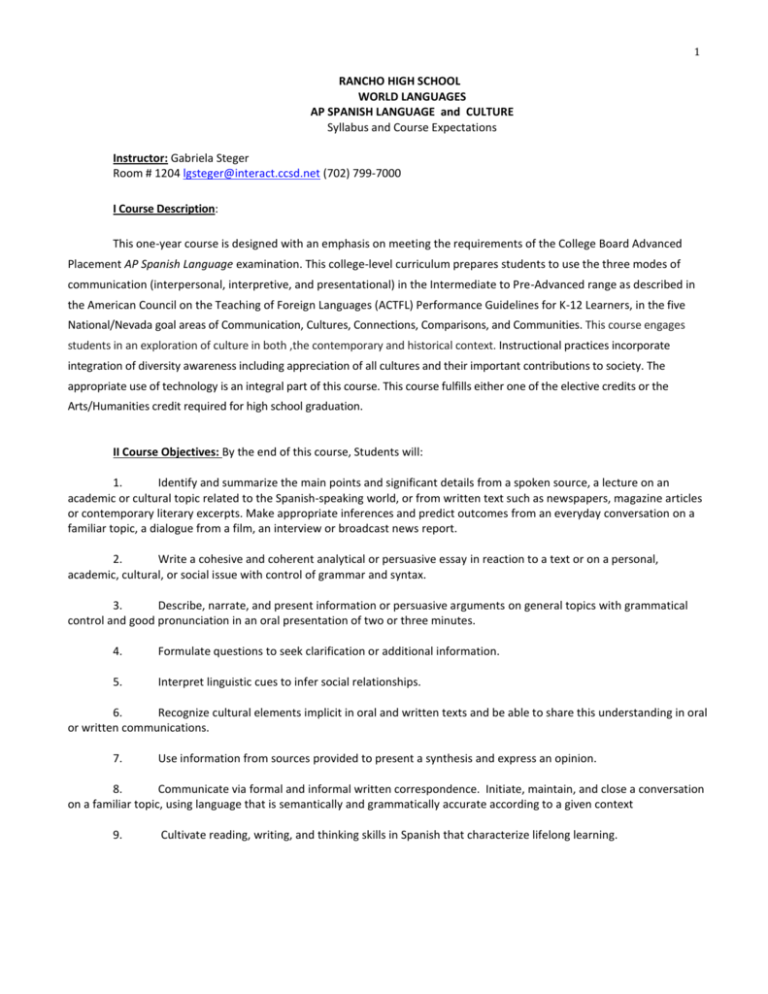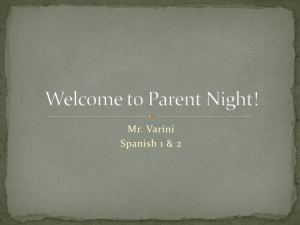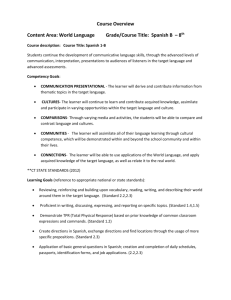
1
RANCHO HIGH SCHOOL
WORLD LANGUAGES
AP SPANISH LANGUAGE and CULTURE
Syllabus and Course Expectations
Instructor: Gabriela Steger
Room # 1204 lgsteger@interact.ccsd.net (702) 799-7000
I Course Description:
This one-year course is designed with an emphasis on meeting the requirements of the College Board Advanced
Placement AP Spanish Language examination. This college-level curriculum prepares students to use the three modes of
communication (interpersonal, interpretive, and presentational) in the Intermediate to Pre-Advanced range as described in
the American Council on the Teaching of Foreign Languages (ACTFL) Performance Guidelines for K-12 Learners, in the five
National/Nevada goal areas of Communication, Cultures, Connections, Comparisons, and Communities. This course engages
students in an exploration of culture in both ,the contemporary and historical context. Instructional practices incorporate
integration of diversity awareness including appreciation of all cultures and their important contributions to society. The
appropriate use of technology is an integral part of this course. This course fulfills either one of the elective credits or the
Arts/Humanities credit required for high school graduation.
II Course Objectives: By the end of this course, Students will:
1.
Identify and summarize the main points and significant details from a spoken source, a lecture on an
academic or cultural topic related to the Spanish-speaking world, or from written text such as newspapers, magazine articles
or contemporary literary excerpts. Make appropriate inferences and predict outcomes from an everyday conversation on a
familiar topic, a dialogue from a film, an interview or broadcast news report.
2.
Write a cohesive and coherent analytical or persuasive essay in reaction to a text or on a personal,
academic, cultural, or social issue with control of grammar and syntax.
3.
Describe, narrate, and present information or persuasive arguments on general topics with grammatical
control and good pronunciation in an oral presentation of two or three minutes.
4.
Formulate questions to seek clarification or additional information.
5.
Interpret linguistic cues to infer social relationships.
6.
Recognize cultural elements implicit in oral and written texts and be able to share this understanding in oral
or written communications.
7.
Use information from sources provided to present a synthesis and express an opinion.
8.
Communicate via formal and informal written correspondence. Initiate, maintain, and close a conversation
on a familiar topic, using language that is semantically and grammatically accurate according to a given context
9.
Cultivate reading, writing, and thinking skills in Spanish that characterize lifelong learning.
2
To achieve these objectives students will engage in the following activities:
Listening Comprehension: Focus on enriching the student’s lexicon, broadening the vocabulary, with advancing
Spanish terminology. Students are exposed to different accents and regionalisms by listening to taped lectures, narratives,
songs, watching films, following with writing and speaking exercises that involve summarizing, giving and opinion, or
answering questions based on the material.
Speaking: The entire course is conducted in Spanish and students will develop the skills to perform a high level of
fluency with good pronunciation. They must be able to narrate, describe and explain correctly using all verbs tenses and
moods. The literary material selected for this class is used to encourage discussion on literary and cultural topics, current
events and personal experiences. Students are expected to incorporate the newly learned vocabulary and idioms from these
lessons into their conversations.
Reading: This AP course exposes students to a wide variety of genre, theme, style length and degree of difficulty in
reading. Abriendo Paso and other sources are used as the basic reading books. By the end of the course, students are
expected to understand both direct and inferred meaning as well as high frequency idiomatic expressions. In addition to the
basic books, students will develop the skills required to understand newspaper and magazine articles, short stories, poetry
and short novels.
Writing: Students will spend a considerable amount of writing, in-and out of class, descriptive, narrative, informative
and persuasive essays. Students are allowed to use a dictionary, collaborative brainstorming and help in the beginning. After
the 2nd quarter, students are expected to write their own compositions without any help. Written work will be accepted, after
students have completed a generalized outline, rough draft, first editing (including peer editing), and marked grammatical and
orthographic errors that are still present. Final pieces should be submitted for a grade, only after the individual student has
completed the process of rectifying suggested corrections. All writing compositions will be critiqued based on the quality of
content, organization, range and appropriateness of vocabulary and grammatical accuracy. These compositions are graded
following the AP writing rubric.
Journal Writing: This is done on a weekly basis on a variety of topics of the instructor’s choice. Students will be
asked to write at least one page of material, in Spanish, using their knowledge of proper Spanish grammar and syntax on the
theme provided.
Grammar: The study of advanced Spanish grammar is designed to help improve the ability of students to express
their ideas accurately and fluently. Students will be assessed through writing, in addition to performing tasks that include
dialogues, poetry, and translations of articles.
History, Art and Culture: This area of advanced Spanish study naturally incorporates the historical components of
the language, including the cultural and artistic influences that are reflected in its everyday uses. Through the discussion of
literary topics, current events, and personal experiences, we will evaluate how, Spanish culture, art and history are integrated
into the Spanish language of today. Throughout the year, culture will be meaningfully connected to reading, writing, listening,
and speaking.
Verbal Presentations: students will give one oral presentation every quarter (in Spanish), critiquing an article from
the local Spanish newspaper, El Mundo. They will also be responsible for watching a local, Spanish television broadcast and
reporting once a quarter on a story they heard (in Spanish). An alternative to this requirement is to present a segment
speaking in Spanish, on the school’s announcements broadcast.
3
III Course Texts and Supplementary Materials:
Primary Texts:
Abriendo Paso Gramática (Prentice Hall) 2012
This is the main grammar source for this course. It provides basic grammar concepts and a variety of examples to
apply the concepts taught.
Abriendo Paso Lectura (Prentice Hall) 2012
This book has a variety of stories and activities that address the development of listening, reading, writing, and
communication skills.
Supplementary Texts:
AP Spanish: Preparing for the Language Examination 3rd Edition 2007 (Prentice Hall)
This book provides a good number of activities that allow the students to familiarize themselves with the structure of
the AP test. Furthermore, it prepares in three of the four skill areas: reading, writing, listening
Triángulo (Wayside Publishing) Opcional.
Triángulo incorporates a mixture of listening, writing, reading and speaking activities, similar to the format of the AP
language exam. It also is the main source for new vocabulary, and places extra stress on the newly revised section of
the AP exam, in which two sources must be used to synthesize material, “ensayo basado en varias fuentes”.
Required Class Materials:
Paper and pencil only, for all Writing, Audio-Video, Listening Activities in class, and while the Textbook is in use.
Spanish Binder provided by the instructor for “Class Use Only” (see contract), with section dividers to organize and
collect all work.
Spanish-English Dictionary is highly recommended.
IV Attendance, Make-up Work, Extra Credit, Citizenship Grade, and Behavior
Attendance and Punctuality: The student is expected to attend ALL classes, be on time, bring a positive attitude, have all
required materials, and complete class-work and homework assignments. Students must be in their seats, with materials, on
or before the bell. Students arriving tardy will be asked to sign in a log.
Class Conduct: All school rules will be adhered to while in this classroom. No electronics, food, drinks, gum chewing or
grooming allowed in this class. No negative interference with the learning-teaching process, personal issues, and other
outside class assignments are permitted. All restroom visits, must be logged by signing out at the door and back in upon
return, except for emergency Nurse’s passes. All instructional materials and persons coming into this classroom will be
treated with respect.
Timely / Make-up work: Homework will be collected at the beginning of class. No late assignments will be accepted unless
pre-arranged or excused. Partial credit will be assigned at the instructor’s discretion. It is the student’s responsibility to timely
contact the instructor for the missed work when absent. It is highly recommended to periodically review the assignments due
dates posted, and acknowledge the procedures in order to guarantee success. It is the student’s responsibility to timely
contact the instructor for missed work. Students are allowed three days after the return from an absence to request the
work, and three days for the assignment to be completed and submitted. Test re-takes, or re-do assignments require
instructor’s approval and a written contract the student must complete.
Extra Credit: Additional points may be granted on selected assignments after completion of ALL required work. These points
may not exceed 10% of the regular credit for that assignment and it is at the teacher’s discretion.
Academic Honesty: Copying, plagiarizing and submitting another’s student’s work is unacceptable and will not be tolerated.
No credit will be given for the assignment. Students will be referred to the administration for further consequences.
Accountability: It is the student’s responsibility to read and sign all class rules (contract) and requirements at the beginning of
the course. Credit will be granted upon returning the “Course Expectations Contract” signed by the student’s parent or
responsible adult in-charge.
Progress Reports: Quarterly reports will be sent out to parents as per CCSD policy. Postings are updated weekly, and are
available for review online. A customized individual report could be printed by request.
4
Citizenship grade Criteria: Awarded at the instructor’s discretion. The following criteria, is intended as a guideline only.
“O” Outstanding – Student maintains irreproachable conduct and stellar performance in class.
“S” Satisfactory – Student Performs to standard levels and keeps the class contract in good standings.
“N” Needs Improvement – Student needs improvement in work ethic and attitude.
“U” Unsatisfactory - Student fails to meet minimum performance standards, and / or has issues with the class contract.
V Making the Grade:
Evaluation
Student progress will be assessed periodically while participating in Guided Practice Activities. Unannounced quizzes
will be given for single topics, revised in class and used as a re-teaching tool.
Assessments may take various forms depending on the subject matter being studied. Some exams require
students to remember specific information from works read, grammatical structures involved and vocabulary learned. Ongoing Formative assessments are done in the areas of speaking and listening. All written assignments are graded using the
AP writing rubrics.
Quarter grades will be calculated as follows:
20% = Daily Work - This includes class participation, target language used, and all
collaborative interactive activities.
20% = Course Work / Homework - Assigned individual guided practice exercises, grammar and writing.
Formative assessments.
20% = Projects - Quarter group or individual projects, Ppt. Verbal presentations.
20% = Writing Journal. Weekly compositions.
20% = Tests, Chapter Exams. Summative assessments.
Grade
A
Scale
90-100%
B
80-89%
C
70-79%
D
60-69%
F
Below 60%
Description of work
Consistently demonstrates an EXCEPTIONAL level of quality and effort.
Having work on time and completed. Demonstrates MASTERY in the use of oral, written
and reading components of the language
Consistently demonstrates proficient knowledge with a GOOD effort and quality of work.
All the assignments are completed and on time.
Demonstrates the ability to utilize the written, oral and reading components of the
language.
Demonstrates proficient knowledge and the ability to apply and utilize the written, oral
and reading components of the language.
Work shows average effort. A few (2-3) assignments may be missed or late.
Work shows minimal effort and some (3 or more) assignments are late. Demonstrates a
basic understanding of recalling or comprehending the written, oral and reading
components of the language.
Understanding is below basic in relation to use of written, oral, and reading components
of the language.
Work is of poor quality and does not meet standards of expectations.
Grade Distribution: Rancho High School has adopted the following school-wide grading policy: each quarter grade
to represent 40% of the semester grade. The semester exam is to represent 20% of the semester grade. Furthermore, the
semester grade is determined using the following values of the letter grades: A=4.0, B=3.0, C=2.0, D=1.0 and F=0
5
VI Topical Timeline
First Semester
Historic and cultural emphasis:
Date
Reading
(From Abriendo Paso,
Lectura unless
otherwise noted *)
Grammar
(Exercises taken from En Marcha
or teacher created worksheets)
Vocabulary
(supplemented from
Triangulo in addition
to vocabulary from
reading)
El Cuerpo
Weeks 1-3
El Décimo, Pardo Bazán
Present tense -Present
Progressive, gerunds Reflexives
Past Participles as
adjectives Present Perfect Past Perfect
Weeks 4-5
Rosa
Preterite tense
Demonstrative Adjectives
Demonstrative Pronouns
Tecnologia
Weeks 6-7
Un Oso y Un Amor
Preterite tense
Irregulars and spelling changes
Animales
Weeks 8-9
* Otras Fábulas
La abeja haragana
Future tense
Adverbs
Medio Ambiente
Weeks 1011
Continuidad de los
Parques
Imperfect tense EM
La Casa
Weeks 1214
Cajas de Carton
Preterite vs. Imperfect -Ser vs.
Estar
Preposiciones de lugar
La Educacion
Preposiciones de
Lugar
Weeks 1415
*Noche de Fugo
Condicional
Passive Voice
El Turismo
Weeks 1617
Jacinto Contreras,
Camilo José Cela
Comparatives
Superlatives
Non Personal verb forms
Ropa
Week 18
Final Exam Review
online
Revisions of Take Home
Essay test
All the grammar
Week 18 b
Finals Review
Finals
6
Second Semester
Date
Week 19
Reading
Don Quixote excerpts
Grammar
Common Errors
Future - Future Perfect
Conditional - Cond. Perfect
Weeks 20-21
Nosotros, No
Adolesencia
Present Subjunctive,
Tener expressions
News Broadcasts
Week 22-23
No Oyes Ladrar los Perros
Proverbios y Cantares,XXIX
Present Subjunctive
Present Perfect Subjunctive
Verbs requiring prep.
La Salud
Week 24-25
El Arbol de Oro, Ana María
Matute
La Camera Prohibida,
Object Pronouns
Commands
El tiempo
Week 26-27
Jaque Mate en dos jugadas
Imperfect Subjunctive
Adjectives
Los deportes
Week 28-29
La Viuda de Montiel, García
Márquez
Despedida
Pluperfect Subjunctive
Prepositions Por and Para
La Ciudad
Weeks 30-31
Cartas de Amor Traicionado
Subjunctive in Adv. clauses
Interrogatives/
Exclamatives
Emociones
Weeks 32-33
Emma Zunz, Jorge Luis Borges Adj. Clauses
Relative Pronouns
Week 34
Spanish pitfalls
Week 35
De La Prensa
Review for AP Test
Week 36
AP Test- El Delantal Blanco
Week 37
El Delantal Blanco
Finals Review
Week 38
Finals Review
Finals
Tense review
Vocabulary
El Comercio
De todo un Poco
Palabras Útiles
7
Additional Activities - Music
Song title
Suerte
No Hay Manera
Visa Para un Sueño
Ojalá que Llueva Café
Cantares
Aguacero
Estoy Aquí
Artist
Shakira
Akwid
Juan Luis Guerra
Juan Luis Guerra
Joan Manuel Serrat
El Gran Combo
Shakira
Associated Literary Work / Unit
Grammar concept
El Décimo
Past Participles
Cajas de Cartón
Subjunctive
Proverbios y Cantares, XXIX
El Árbol de Oro
D.O. & I.O. pronouns
Cultural and Country Study- Each unit will feature a cultural or country/region emphasis.
Students will each pick a country and will lead the discussion when it is time for their country to
be featured. Students will be encouraged to include current events for their country
presentation.
Unit
1
2
3
4
5
6
7
8
10
11
12
13
14
15
16
Cultural and Historical Concentration
Hispanics in the USA
Geography of Spain
History of Spain
España
Geography of Latin America
History of Latin America
México
Guatemala, Honduras, Los Mayas
Costa Rica, Nicaragua, Panamá, El Salvador
El Caribe
Colombia, Ecuador, Venezuela
Chile
Bolivia and Paraguay
Perú y Los Incas
Argentina and Uruguay
8
Online Resources/ Newspapers/ Periodicals/ http://www.clarin.com/
The New Frontier www.time.com/time/covers/1101010611/nachtwey/
http://www.youtube.com/
http://www.univision.com/portal.jhtml
http://www.nacion.com
Movies/ Televisión Series (1 shown each 9 weeks- students write reviews in Spanish)
Alborada- Colonial Latin American love story
Televisa Xenon Pictures, Santa Monica, CA
Silencio Roto- Political Drama in the wake of the Spanish Civil war
Latino Vanguard Cinema
El Destino no Tiene Favoritos- Peruvian comedy
Wellspring, Alvaro Velarde Productions,
Danzón- Mexican music and dance “road” movie
Columbia Tristar Home Video, Burbank, CA
Grammar and Reading Resources
People Magazine En Español
Imagina, Español sin barreras (Vista Higher Learning)
Repaso, Review workbook for Grammar, Communication & Culture
(National Textbook Co.)
Una Vez Más, (Couch et. al.; Longman Publishing)
Complete Spanish Grammar (Nissenberg; McGraw Hill)
Spanish 3 years (Amsco Publishers)
Nuestro Mundo (D.C. Heath and Company)
Bibliography
Abriendo Paso, Gramatica Diaz, Jose M., Maria F. Nadel and Stephen J. Collins.
Abriendo Paso, Lectura, Boston, Massachusetts: Pearson Prentice Hall, 2012.
Gatski, Barbara and John McMullan.
Triangulo, 4th Ed. Sandwich, Massachusetts: Wayside Publishing, 2006
Diaz, Jose M. and Maria F. Nadel.
En Marcha, Upper Saddle River, New Jersey: Prentice-Hall Inc., 2001
Valette, Rebecca M. and Joy REnjilian-Burgy. Album. 2nd ed.
Lexington, Massachusetts: D.C. Heath and Company. 1993. Ramirez, Lori Langer
Cuentame Folklore y Fabulas, Amsco School Publishing Inc., 1999





